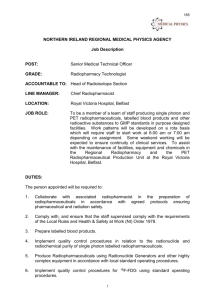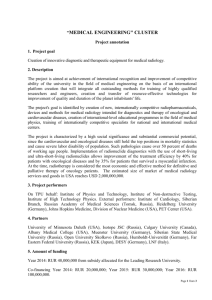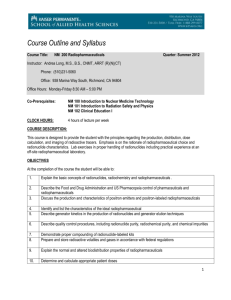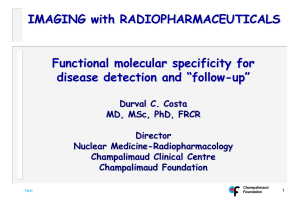Document 13960023
advertisement
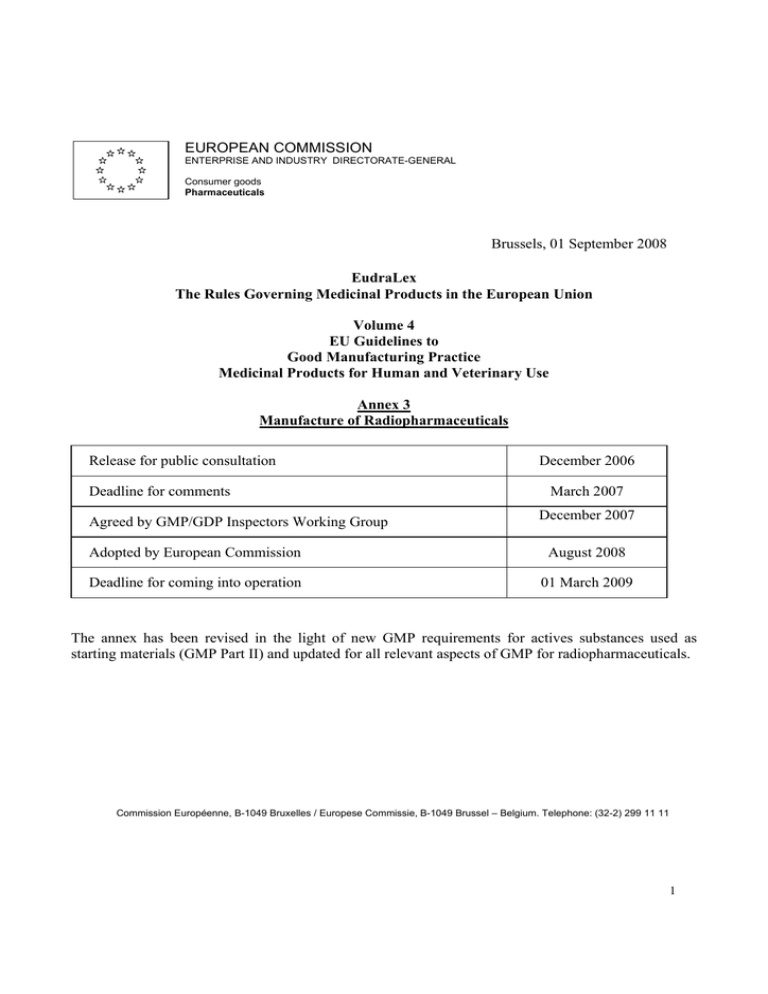
EUROPEAN COMMISSION ENTERPRISE AND INDUSTRY DIRECTORATE-GENERAL Consumer goods Pharmaceuticals Brussels, 01 September 2008 EudraLex The Rules Governing Medicinal Products in the European Union Volume 4 EU Guidelines to Good Manufacturing Practice Medicinal Products for Human and Veterinary Use Annex 3 Manufacture of Radiopharmaceuticals Release for public consultation Deadline for comments Agreed by GMP/GDP Inspectors Working Group December 2006 March 2007 December 2007 Adopted by European Commission August 2008 Deadline for coming into operation 01 March 2009 The annex has been revised in the light of new GMP requirements for actives substances used as starting materials (GMP Part II) and updated for all relevant aspects of GMP for radiopharmaceuticals. Commission Européenne, B-1049 Bruxelles / Europese Commissie, B-1049 Brussel – Belgium. Telephone: (32-2) 299 11 11 1 Annex 3 Manufacture of Radiopharmaceuticals Principle The manufacture of radiopharmaceuticals shall be undertaken in accordance with the principles of Good Manufacturing Practice for Medicinal Products Part I and II. This annex specifically addresses some of the practices, which may be specific for radiopharmaceuticals. Note i. Preparation of radiopharmaceuticals in radiopharmacies (hospitals or certain pharmacies), using Generators and Kits with a marketing authorisation or a national licence, is not covered by this guideline, unless covered by national requirement. Note ii. According to radiation protection regulations it should be ensured that any medical exposure is under the clinical responsibility of a practitioner. In diagnostic and therapeutic nuclear medicine practices a medical physics expert shall be available. Note iii. This annex is also applicable to radiopharmaceuticals used in clinical trials. Note iv. Transport of radiopharmaceuticals is regulated by the International Atomic Energy Association (IAEA) and radiation protection requirements. Note v. It is recognised that there are acceptable methods, other than those described in this annex, which are capable of achieving the principles of Quality Assurance. Other methods should be validated and provide a level of Quality Assurance at least equivalent to those set out in this annex. Introduction 1. The manufacturing and handling of radiopharmaceuticals is potentially hazardous. The level of risk depends in particular upon the types of radiation, the energy of radiation and the half-lives of the radioactive isotopes. Particular attention must be paid to the prevention of cross contamination, to the retention of radionuclide contaminants, and to waste disposal. 2. Due to short shelf-life of their radionuclides, some radiopharmaceuticals may be released before completion of all quality control tests. In this case, the exact and detailed description of the whole release procedure including the responsibilities of the involved personnel and the continuous assessment of the effectiveness of the quality assurance system is essential. 2 3. This guideline is applicable to manufacturing procedures employed by industrial manufacturers, Nuclear Centres/Institutes and PET Centres for the production and quality control of the following types of products: Radiopharmaceuticals Positron Emitting (PET) Radiopharmaceuticals Radioactive Precursors for radiopharmaceutical production Radionuclide Generators Type of manufacture Non - GMP * GMP part II & I (Increasing) including relevant annexes Radiopharmaceuticals PET Radiopharmaceuticals Radioactive Precursors Reactor/Cyclotron Chemical Purification Production synthesis steps Radionuclide Generators Reactor/Cyclotron Processing Production Processing, Aseptic or final formulation and sterilization dispensing * Target and transfer system from cyclotron to synthesis rig may be considered as the first step of active substance manufacture. 4. The manufacturer of the final radiopharmaceutical should describe and justify the steps for manufacture of the active substance and the final medicinal product and which GMP (part I or II) applies for the specific process/manufacturing steps. 5. Preparation of radiopharmaceuticals involves adherence to regulations on radiation protection. 6. Radiopharmaceuticals to be administered parenterally should comply with sterility requirements for parenterals and, where relevant, aseptic working conditions for the manufacture of sterile medicinal products, which are covered in Eudralex Volume 4, Annex 1. 7. Specifications and quality control testing procedures for the most commonly used radiopharmaceuticals are specified in the European Pharmacopoeia or in the marketing authorisation. Clinical Trials 8. Radiopharmaceuticals intended for use in clinical trials as investigational medicinal products should in addition be produced in accordance with the principles in Eudralex Volume 4, annex 13. Quality assurance 9. Quality assurance is of even greater importance in the manufacture of radiopharmaceuticals because of their particular characteristics, low volumes and in some circumstances the need to administer the product before testing is complete. 3 10. As with all pharmaceuticals, the products must be well protected against contamination and crosscontamination. However, the environment and the operators must also be protected against radiation. This means that the role of an effective quality assurance system is of the utmost importance. 11. It is important that the data generated by the monitoring of premises and processes are rigorously recorded and evaluated as part of the release process. 12. The principles of qualification and validation should be applied to the manufacturing of radiopharmaceuticals and a risk management approach should be used to determine the extent of qualification/validation, focusing on a combination of Good Manufacturing Practice and Radiation Protection. Personnel 13. All manufacturing operations should be carried out under the responsibility of personnel with additional competence in radiation protection. Personnel involved in production, analytical control and release of radiopharmaceuticals should be appropriately trained in radiopharmaceutical specific aspects of the quality management system. The QP should have the overall responsibility for release of the products. 14. All personnel (including those concerned with cleaning and maintenance) employed in areas where radioactive products are manufactured should receive appropriate additional training specific to these types of procedures and products 15. Where production facilities are shared with research institutions, the research personnel must be adequately trained in GMP regulations and the QA function must review and approve the research activities to ensure that they do not pose any hazard to the manufacturing of radiopharmaceuticals. Premises and equipment General 16. Radioactive products should be manufactured in controlled (environmental and radioactive) areas. All manufacturing steps should take place in self-contained facilities dedicated to radiopharmaceuticals 17. Measures should be established and implemented to prevent cross-contamination from personnel, materials, radionuclides etc. Closed or contained equipment should be used whenever appropriate. Where open equipment is used, or equipment is opened, precautions should be taken to minimize the risk of contamination. The risk assessment should demonstrate that the environmental cleanliness level proposed is suitable for the type of product being manufactured. 18. Access to the manufacturing areas should be via a gowning area and should be restricted to authorised personnel. 4 19. Workstations and their environment should be monitored with respect to radioactivity, particulate and microbiological quality as established during performance qualification (PQ). 20. Preventive maintenance, calibration and qualification programmes should be operated to ensure that all facilities and equipment used in the manufacture of radiopharmaceutical are suitable and qualified. These activities should be carried out by competent personnel and records and logs should be maintained. 21. Precautions should be taken to avoid radioactive contamination within the facility. Appropriate controls should be in place to detect any radioactive contamination, either directly through the use of radiation detectors or indirectly through a swabbing routine. 22. Equipment should be constructed so that surfaces that come into contact with the product are not reactive, additive or absorptive so as to alter the quality of the radiopharmaceutical. 23. Re-circulation of air extracted from area where radioactive products are handled should be avoided unless justified. Air outlets should be designed to minimize environmental contamination by radioactive particles and gases and appropriate measures should be taken to protect the controlled areas from particulate and microbial contamination. 24. In order to contain radioactive particles, it may be necessary for the air pressure to be lower where products are exposed, compared with the surrounding areas. However, it is still necessary to protect the product from environmental contamination. This may be achieved by, for example, using barrier technology or airlocks, acting as pressure sinks. Sterile production 25. Sterile radiopharmaceuticals may be divided into those, which are manufactured aseptically, and those, which are terminally sterilised. The facility should maintain the appropriate level of environmental cleanliness for the type of operation being performed. For manufacture of sterile products the working zone where products or containers may be exposed to the environment, the cleanliness requirements should comply with the requirements described in the Eudralex Volume 4, Annex 1. 26. For manufacture of radiopharmaceuticals a risk assessment may be applied to determine the appropriate pressure differences, air flow direction and air quality. 27. In case of use of closed and automated systems (chemical synthesis, purification, on-line sterile filtration) a grade C environment (usually “Hot-cell”) will be suitable. Hot-cells should meet a high degree of air cleanliness, with filtered feed air, when closed. Aseptic activities must be carried out in a grade A area. 28. Prior to the start of manufacturing, assembly of sterilised equipment and consumables (tubing, sterilised filters and sterile closed and sealed vials to a sealed fluid path) must be performed under aseptic conditions 5 Documentation 29. All documents related to the manufacture of radiopharmaceuticals should be prepared, reviewed, approved and distributed according to written procedures. 30. Specifications should be established and documented for raw materials, labelling and packaging materials, critical intermediates and the finished radiopharmaceutical. Specifications should also be in place for any other critical items used in the manufacturing process, such as process aids, gaskets, sterile filtering kits, that could critically impact on quality. 31. Acceptance criteria should be established for the radiopharmaceutical including criteria for release and shelf life specifications (examples: chemical identity of the isotope, radioactive concentration, purity, and specific activity). 32. Records of major equipment use, cleaning, sanitisation or sterilisation and maintenance should show the product name and batch number, where appropriate, in addition to the date and time and signature for the persons involved in these activities. 33. Records should be retained for at least 3 years unless another timeframe is specified in national requirements. Production 34. Production of different radioactive products in the same working area (i.e. hot-cell, LAF unit), at the same time should be avoided in order to minimise the risk of radioactive cross-contamination or mix-up. 35. Special attention should be paid to validation including validation of computerised systems which should be carried out in accordance in compliance with Eudralex Volume 4, annex 11. New manufacturing processes should be validated prospectively. 36. The critical parameters should normally be identified before or during validation and the ranges necessary for reproducible operation should be defined. 37. Integrity testing of the membrane filter should be performed for aseptically filled products, taking into account the need for radiation protection and maintenance of filter sterility. 38. Due to radiation exposure it is accepted that most of the labelling of the direct container, is done prior to manufacturing. Sterile empty closed vials may be labelled with partial information prior to filling providing that this procedure does not compromise sterility or prevent visual control of the filled vial. 6 Quality control 39. Some radiopharmaceuticals may have to be distributed and used on the basis of an assessment of batch documentation and before all chemical and microbiology tests have been completed. Radiopharmaceutical product release may be carried out in two or more stages, before and after full analytical testing: a) Assessment by a designated person of batch processing records, which should cover production conditions and analytical testing performed thus far, before allowing transportation of the radiopharmaceutical under quarantine status to the clinical department. b) Assessment of the final analytical data, ensuring all deviations from normal procedures are documented, justified and appropriately released prior to documented certification by the Qualified Person. Where certain test results are not available before use of the product, the Qualified Person should conditionally certify the product before it is used and should finally certify the product after all the test results are obtained. 40. Most radiopharmaceuticals are intended for use within a short time and the period of validity with regard to the radioactive shelf-life, must be clearly stated. 41. Radiopharmaceuticals having radionuclides with long half-lives should be tested to show, that they meet all relevant acceptance criteria before release and certification by the QP. 42. Before testing is performed samples can be stored to allow sufficient radioactivity decay. All tests including the sterility test should be performed as soon as possible. 43. A written procedure detailing the assessment of production and analytical data, which should be considered before the batch is dispatched, should be established. 44. Products that fail to meet acceptance criteria should be rejected. If the material is reprocessed, preestablished procedures should be followed and the finished product should meet acceptance criteria before release. Returned products may not be reprocessed and must be stored as radioactive waste. 45. A procedure should also describe the measures to be taken by the Qualified Person if unsatisfactory test results (Out-of-Specification) are obtained after dispatch and before expiry. Such events should be investigated to include the relevant corrective and preventative actions taken to prevent future events. This process must be documented. 46. Information should be given to the clinical responsible persons, if necessary. To facilitate this, a traceability system should be implemented for radiopharmaceuticals. 47. A system to verify the quality of starting materials should be in place. Supplier approval should include an evaluation that provides adequate assurance that the material consistently meets specifications. The starting materials, packaging materials and critical process aids should be purchased from approved suppliers. 7 Reference and Retention samples 48. For radiopharmaceuticals sufficient samples of each batch of bulk formulated product shall be retained for at least six months after expiry of the finished medicinal product unless otherwise justified through risk management. 49. Samples of starting materials, other than solvents gases or water used in the manufacturing process shall be retained for at least two years after the release of the product. That period may be shortened if the period of stability of the material as indicated in the relevant specification is shorter. 50. Other conditions may be defined by agreement with the competent authority, for the sampling and retaining of starting materials and products manufactured individually or in small quantities or when their storage could raise special problems. Distribution 51. Distribution of the finished product under controlled conditions, before all appropriate test results are available, is acceptable for radiopharmaceuticals, providing the product is not administered by the receiving institute until satisfactory test results has been received and assessed by a designated person. 10. Glossary Preparation: handling and radiolabelling of kits with radionuclide eluted from generators or radioactive precursors within a hospital. Kits, generators and precursors should have a marketing authorisation or a national licence. Manufacturing: production, quality control and release and delivery of radiopharmaceuticals from the active substance and starting materials. Hot –cells: shielded workstations for manufacture and handling of radioactive materials. Hot-cells are not necessarily designed as an isolator. Qualified person: QP as described in Directives 2001/83/EC and 2001/82/EC. QP responsibilities are elaborated in Eudralex Volume 4, annex 16. 8
